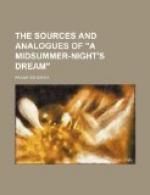For nine years Eochaid waged war against Mider, digging into the elf-mounds, until he hit upon the fairy-mansion; whereupon Mider sent to the side of the palace sixty women, all exactly like Etain. And first the king carried away the wrong woman, but when he returned to sack Bri Leith, Etain made herself known to him, and he bore her back to the palace at Tara.
It is reasonable to suppose, then, that some Armorican bard, hearing the classical tale of Orpheus and Eurydice, remembered the Celtic legend of Eochaid and Etain, and grafted the one on the other. Hades became Bri Leith, or the vaguely-defined beautiful unknown country; but the classical names displaced the Celtic. The confusion, however, did not at once cease. In one of the MSS. of Sir Orfeo it is said that Orfeo’s father
“Was comen of king Pluto,
And his moder of king Juno”
—confusion worse confounded. Moreover, as we have already seen, even Chaucer called the fairy-king Pluto and the queen Proserpina.
Again, to hark back to the other romances, we have found the word fay attached to the name of King Arthur’s sister Morgan. Nothing is more remarkably certain than the close and constant association in mediaeval lore of the fairies and the fairy-world with the Arthurian cycle of romance;[74] King Arthur’s sister was Morgan le Fay, whose son by Ogier was Merlin; and the romance of Huon of Bordeaux, which relates these facts, though strictly belonging to the Charlemagne cycle, contains the account of Oberon’s bequest of his realm to King Arthur. Chaucer, whatever other doubts he may have had, was convinced on this point:—[75]
“In th’ olde daies of the
King Arthoure,
Of which that Bretons speken gret honoure,
Al was this land fulfild of fayerye;
The elfqueen with hir joly companye
Daunced ful ofte in many a grene mede;
This was the olde opinion as I rede.”
Now the Arthurian legends ultimately derive from Celtic tales, which must be supposed to have travelled from Wales into France by way of Brittany—Little Britain, or Armorica—in the eleventh and twelfth centuries; for there are Welsh versions independent of the Breton forms, though closely akin. Students of early Celtic literature have not as yet agreed about the historical relations between Welsh and Irish stories—whether the Welsh imposed their mythology and heroic legends on the Irish, or vice versa; but the general similarity between them is undeniable, and easily explicable by a common Celtic source.




